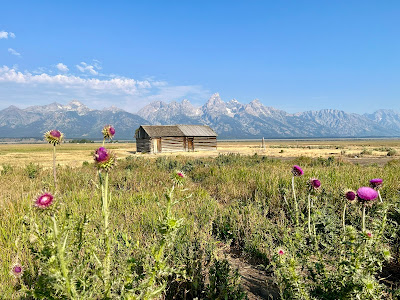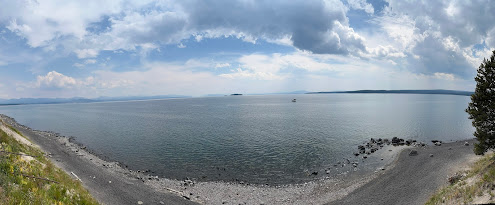Our trip to and from the national parks was mainly filled with driving - two days each way. We did listen to audio books, and I took several photos from the passenger seat, zipping along at 80 MPH as the flatlands of our part of Kansas transitioned to hills and then mountains.
At the beginning, I admit I was getting kind of "itchy" about my lack of quality photos.
But then I saw a road sign, saying that the Little Big Horn Battlefield National Monument was coming up. It didn't take a lot of convincing for Randy to stop to stretch our legs and to take a break from the car. It is out in the middle of nowhere - which is no surprise. The town of Hardin, Montana, is 15 miles north. The nearest bigger cities are Billings, Montana, 65 miles northwest, and Sheridan, Wyoming, 70 miles south.
Like Arlington National Cemetery, the Custer National Cemetery.provides a final resting place for many generations of those who faithfully served in the U.S. armed forces.
Here, Americans of many races and beliefs rest side by side.
There are graves of known and unknown veterans, women and children from isolated frontier posts, Indians, scouts and Medal of Honor recipients. Veterans of 20th century wars rest there, too.
The War Department established the cemetery in 1879, three years after the Battle of Little Bighorn. Remains from 25 cemeteries were transferred here when frontier forts closed at the end of the Indian Wars.
The fallen from many famous battles now rest here, including Fetterman, Wagon Box, Hayfield, Big Hole and Bear Paw.
Until reaching capacity in 1978, the cemetery accepted burial reservations for veterans and their spouses. They include veterans from the Indian Wars, Spanish American War, World Wars I and II, Korean War and Vietnam War.
The Battle of the Little Bighorn was fought along the ridges, steep bluffs, and ravines of the Little Bighorn River, in south-central Montana on June 25-26, 1876. The combatants were warriors of the Lakota Sioux, Northern Cheyenne, and Arapaho tribes, battling men of the 7th Regiment of the U.S. Cavalry, along with their Crow and Arikara scouts. The Battle of the Little Bighorn has come to symbolize the clash of two vastly dissimilar cultures: the buffalo/horse culture of the northern plains tribes, and the highly industrial based culture of the United States. This battle was not an isolated confrontation, but part of a much larger strategic campaign designed to force the capitulation of the non-reservation Lakota and Cheyenne.
In 1868, after fierce fighting from 1865-1867 between U.S. Army personnel and Lakota and Cheyenne warriors, several Lakota leaders agreed to sign the Treaty of Fort Laramie. This treaty created a large reservation for the Lakota in the western half of present-day South Dakota; the Lakota's beloved Black Hills area. The United States wanted tribes to give up their nomadic life which brought them into conflict with other Indians, white settlers and railroads. Agreeing to the treaty meant accepting a more stationary life and relying on government-supplied subsidies.
However, Lakota leaders such as Sitting Bull and Crazy Horse rejected the reservation system. That led to the Battle of Little Big Horn, in which Lt. Col. George Custer and many of his troops perished. It was originally named Custer National Cemetery. But, after decades of advocacy on the part of indigenous groups, President George H.W. Bush changed the name to Little Bighorn Battlefield National Monument in 1991 to recognize indigenous perspectives and those who fought at the site.
The Visitor's Center was closed for remodeling during our visit. But that was just as well. After wandering around for a little while, we got back on the road.
NOTE: This was actually our first "tourist stop" on the trip. I didn't want to start my travelogue with this, but I did want to save the photos and have a blog post about our visit. So you get a little "fruit-basket-upset with this particular post.
For those who've read to THE END, thanks for sticking with me.























































